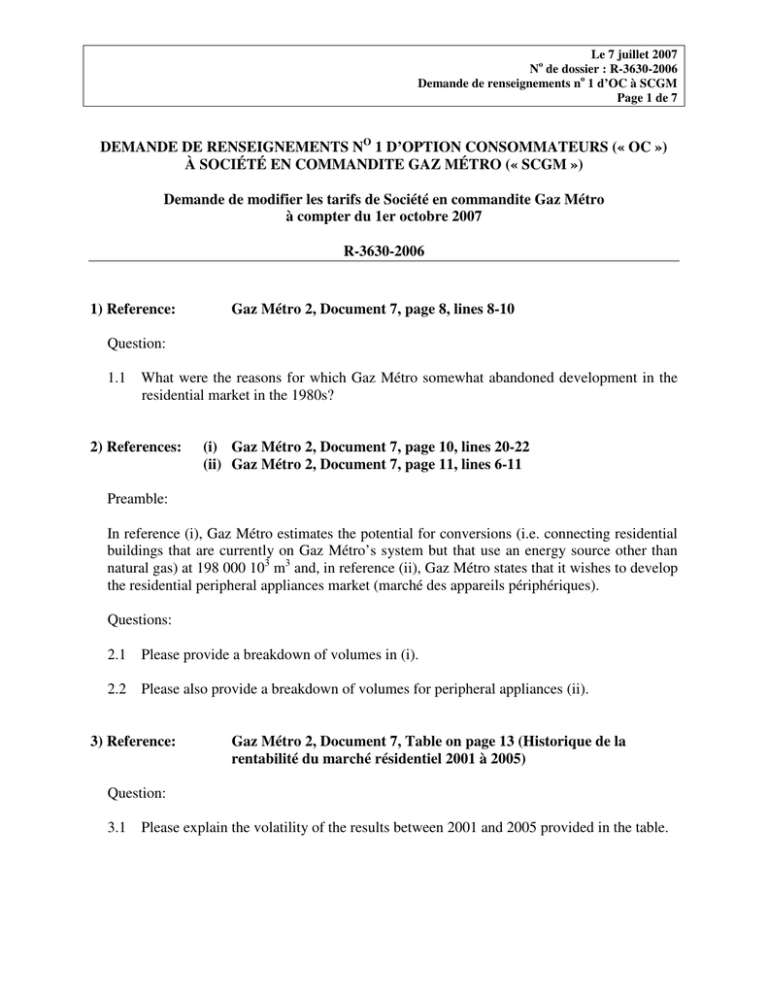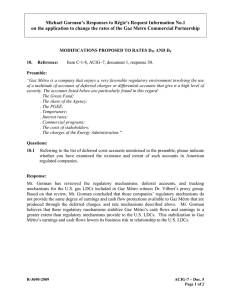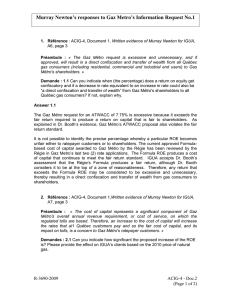DEMANDE DE RENSEIGNEMENTS N 1 D’OPTION CONSOMMATEURS (« OC »)
advertisement

Le 7 juillet 2007 No de dossier : R-3630-2006 Demande de renseignements no 1 d’OC à SCGM Page 1 de 7 DEMANDE DE RENSEIGNEMENTS NO 1 D’OPTION CONSOMMATEURS (« OC ») À SOCIÉTÉ EN COMMANDITE GAZ MÉTRO (« SCGM ») Demande de modifier les tarifs de Société en commandite Gaz Métro à compter du 1er octobre 2007 R-3630-2006 1) Reference: Gaz Métro 2, Document 7, page 8, lines 8-10 Question: 1.1 What were the reasons for which Gaz Métro somewhat abandoned development in the residential market in the 1980s? 2) References: (i) Gaz Métro 2, Document 7, page 10, lines 20-22 (ii) Gaz Métro 2, Document 7, page 11, lines 6-11 Preamble: In reference (i), Gaz Métro estimates the potential for conversions (i.e. connecting residential buildings that are currently on Gaz Métro’s system but that use an energy source other than natural gas) at 198 000 103 m3 and, in reference (ii), Gaz Métro states that it wishes to develop the residential peripheral appliances market (marché des appareils périphériques). Questions: 2.1 Please provide a breakdown of volumes in (i). 2.2 Please also provide a breakdown of volumes for peripheral appliances (ii). 3) Reference: Gaz Métro 2, Document 7, Table on page 13 (Historique de la rentabilité du marché résidentiel 2001 à 2005) Question: 3.1 Please explain the volatility of the results between 2001 and 2005 provided in the table. Le 7 juillet 2007 No de dossier : R-3630-2006 Demande de renseignements no 1 d’OC à SCGM Page 2 de 7 4) References: (i) Gaz Métro 2, Document 7, page 19, lines 7-9 (ii) Gaz Métro 2, Document 7, page 20 Questions: 4.1 With regards to reference (i), explain how the new rate design proposal would not significantly modify cross-subsidization levels between rates. 4.2 Does Gaz Métro intend to reduce cross-subsidization levels within the D1 rate structure? 4.3 With regards to reference (ii), please provide cross-subsidization levels (or revenue/cost ratios) for each tier and sub-tier of the D1 tariff (paliers et sous-paliers). In providing the revenue-to-cost ratios, please include only distribution costs (i.e., exclude commodity and any upstream storage balancing or transportation costs). 5) Reference: Gaz Métro 2, Document 7, page 22, lines 5-10 Questions: 5.1 Please define, and explain, the criteria Gaz Métro used to define a minimal internal rate of return (IRR) or target profitability (TRI ou rentabilité cible) of 9,5% and the breakeven point (point mort tarifaire) of 11 years for its residential development. 5.2 Do the target profitability and breakeven point set for residential development projects on page 22 apply equally to both infill projects (conversion/densification) and system extensions (nouvelle construction/extensions de réseau) or do they apply to the residential development segment taken as a whole? Explain your answer. 5.3 If applicable, please specify the target profitability and breakeven point for each segment. 5.4 When evaluating investment opportunities for residential development projects, does Gaz Métro make use of other investment tools such as, for example, the net present value or a “profitability index”? 5.4.1 If yes to question 5.4, please provide the details. 5.4.2 If no to question 5.4, please explain the advantages of using criteria such as the internal rate of return and payback period (or breakeven point) as opposed to a criterion based on a non-negative net present value (NPV) or a profitability index (PI) greater than 1.0 for new connections (with contributions in aid of construction recognized in the calculation of NPV or PI). Le 7 juillet 2007 No de dossier : R-3630-2006 Demande de renseignements no 1 d’OC à SCGM Page 3 de 7 5.5 The payback period criterion suggests that Gaz Métro may have some liquidity or cash flow issues. If so, please provide details. If not, please explain the appropriateness of this criterion for a capital-intensive entity providing service over the long term with long-lived assets. 6) Reference: Gaz Métro 2, Document 7, pages 24-26 (4.2.2 Intégration des nouvelles technologies) Questions: 6.1 With regards to new technologies, other than the two technologies discussed under 4.2.2 (geoexchange and solar), are there any other technologies that should be considered complementary to natural gas technologies? 6.2 When does Gaz Métro expect these technologies will be applied by its D1 tariff customers and what specific impact does Gaz Métro expect the integration of these technologies will have on the D1 Tariff? 7) Reference: Gaz Métro 2, Document 7, page 28-29 (Plan d’ajustement des aides financières) Question: 7.1 Did Gaz Métro evaluate alternative scenarios to assess profitability levels if it were to reduce substantially or eliminate its subsidy program for residential development projects? 7.2 If yes to question 7.1, please provide details. If no, please explain why not. 8) References: (i) Gaz Métro 7, Document 2, pages 49-51 (ii) Gaz Métro 7, Document 7, page 74, lines 15-18 Questions: 8.1 Did Gaz Métro approve all the survey questions asked by the consulting firm to Gaz Métro’s customers? 8.2 On what basis was the margin of error for survey results established, specifically in regards to the survey referred to in reference (i)? Le 7 juillet 2007 No de dossier : R-3630-2006 Demande de renseignements no 1 d’OC à SCGM Page 4 de 7 8.3 What is the margin of error of survey results for survey conducted in reference (ii) which was specifically geared toward for low-income customers and how was this margin of error determined? 8.4 Why was a 10-year period chosen for the survey questions referred to on pages 49-51 rather than a 5-year or lesser period? 8.5 Following the survey questions regarding the fixed versus variable pricing models, were those surveyed asked how the implementation of one or the other of the pricing models themselves would influence their decision as to whether or not to opt for natural gas. If so, please submit the results. If not, please explain why not? 9) Reference: Gaz Métro 2, Document 7, page 67, lines 18-23 Questions: 9.1 Please confirm that Gaz Métro has fewer customers than it does meters for the D1 tariff. Please provide numbers for each item and explain any variances. 9.2 How many meters do you project for 2008-2009 for the D1 tariff? 10) Reference: Gaz Métro 2, Document 7, page 69, lines 2-14 Questions: 10.1 Please indicate how many customers were billed in each of the first two tiers of the D1 tariff (ie, 0 – 10 950 m3 and 10 950 – 36 500 m3) according to your 2006 analysis. 10.2 For those customers billed in more than one tier (28% of the customer base), please indicate which range of tier they covered (i.e., please provide a breakdown showing the number of customers consuming in each tier). 10.3 If the Régie were to accept Gaz Métro’s proposal to increase the basic fee (frais de base) from 25¢ to 46¢ and above, a larger proportion of Gaz Métro’s fixed costs would be collected through the basic fee. Gaz Métro would then face a lower risk of underrecovery of fixed costs due to warmer weather and decreasing average use per customer. With greater certainty in cost recovery and greater stabilization of its revenues due to these lowered risks, would Gaz Métro consider it appropriate to have a lower return on equity (ROE)? Please explain your answer. Le 7 juillet 2007 No de dossier : R-3630-2006 Demande de renseignements no 1 d’OC à SCGM Page 5 de 7 11) Reference: Gaz Métro 2, Document 7, page 71, lines 21-25 Question: 11.1 Did Gaz Métro consider other options to mitigate or reduce the impacts to “small customers”? 11.2 If yes to question 11.1, please provide a list and a description of options assessed and the reasons for which each was discarded. If not, please explain the reasons for which it did not carry out this analysis. 12) References: (i) Gaz Métro 2, Document 7, First Table on page 73 (ii) Gaz Métro 2, Document 7, page 79, lines 11-23 (Date d’implantation souhaitée) Questions: 12.1 Considering the significant financial impact of Gaz Métro’s proposal on customers billed in the first sub-tier of the D1 tariff (i.e., customers whose consumption does not exceed 1095 m3/year), did Gaz Métro consider implementing its rate design proposal over a period of two or more years? 12.2 Please list, and explain, the results of phasing-in Gaz Métro’s proposal to increase the basic fee? 13) Reference: Gaz Métro 2, Document 7, page 76, lines 14-31, page 77 and page 78, lines 1-16 (Enjeu no 2: besoin de mise en place d’un programme de réduction de l’impact de la proposition tarifaire pour la clientèle à faible revenu) Preamble: Gaz Métro proposes a mitigation program for low-income customers billed only in the first sub-tier of the D1 tariff on the basis that this is where the proposal has the greatest financial impact. The program consists in providing a rebate applicable to the basic fee, equivalent to the increase of the basic fee, so as to keep the basic fee for low-income customers at the same level (i.e. 25¢ per meter per day). Questions: 13.1 Please indicate how this program would be financed. Le 7 juillet 2007 No de dossier : R-3630-2006 Demande de renseignements no 1 d’OC à SCGM Page 6 de 7 13.2 Please indicate whether Gaz Métro has considered providing a stipend or other form of compensation to community groups performing the identification of low-income customers. 13.3 If yes to the previous question, please explain what Gaz Métro would consider an appropriate level of compensation. 13.4 How will community-based groups identify low-income customers? 13.5 Please detail Gaz Métro’s role in the identification of low-income customers? 13.6 Does Gaz Métro intend on making this program permanent? Explain your answer. 13.7 Please confirm that, in compliance with Gaz Métro’s proposal, only low-income customers whose consumption is below 1095 m3/year would benefit from the proposed rebate. 13.8 Please explain how the financial limitations of low-income customers whose consumption exceeds 1095 m3/year have been taken into account. 13.9 Please also confirm that if 64% of low-income customers eventually did participate in the rebate program (Gaz Métro 7, doc.2, lines 27-29), no additional measure would be taken to offset the proposed fixed rate increase for the remaining 36% of such customers whose consumption falls within the first sub-tier of the D1 tariff. 14) Reference: Gaz Métro 7, Document 2, page 77, lines 18-20 Preamble: Gaz Métro suggests that community-based organizations provide Gaz Métro with a list of customers that wish to have access to the proposed rebate and that this list be completed at a set date every year so as to adequately plan the rate impacts. Questions: 14.1 Please list all the specific objectives Gaz Métro seeks to achieve by updating the list at a specific date every year? 14.2 Does Gaz Métro’s proposal to update the list of low-income customers at a fixed date every year imply that low-income customers wishing to have access to the rebate would only be eligible to do so if they are included in the list provided once yearly or can customers have access to the rebate at any time? Le 7 juillet 2007 No de dossier : R-3630-2006 Demande de renseignements no 1 d’OC à SCGM Page 7 de 7 15) Reference: Gaz Métro 2, Document 7, page 79, lines 1-10, page 88, lines 17-29 and page 89, lines 1-8 (Frais de remise en service) Preamble: Gaz Métro explains that the current level for the reconnection charge (frais de remise en service) of $50 does not allow it to cover its full costs and deprives Gaz Métro of additional distribution revenues while meters are not in use. Therefore, Gaz Métro proposes to calculate reconnection charges based on actual costs and to set this fee at $218 for residential customers, as of October 1, 2007. Questions: 15.1 Please detail how many residential customers have been disconnected per year, in the past five years, because they had not paid their arrears. Also provide the data by sub-tier if possible. 15.2 Please detail, per year and over the past five years, how many residential customers have temporarily disconnected their natural gas service at their own request. 15.3 Please explain how Gaz Métro proposes to mitigate the impact of the proposed reconnection fees on low-income customers that do not have the financial means to pay the new fees.


